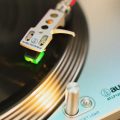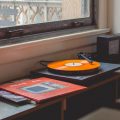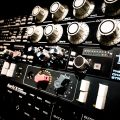Whether you prefer digital tunes or the nostalgia of analog music, one thing’s for sure – the LP records changed music forever. In this article, we’ll dive into what makes them unique, how they work, and what sets them apart from other vinyl record formats.
Table of Contents
What is an LP Record?
You might be wondering, what exactly is an LP record? Well, let’s unravel this musical enigma.
LP stands for “Long Play” and it’s essentially a full-length vinyl record that’s 12 inches in diameter and spins at 33 and 1/3 revolutions per minute.
Invented in 1948 and reaching its zenith of popularity during the 1960s, LPs succeeded the earlier shellac-based “78” records and revolutionized the way we experience music.
What sets LPs apart is their ability to offer an extended duration of audio playback, accommodating up to 20-30 minutes of music on each side. It’s a medium that gives you the full album experience, making it a cherished choice for audiophiles.
When played on a turntable or record player, a stylus needle delicately travels through its grooves, translating those distinctive patterns into the warm, slightly “crackly” sound that many of us have come to adore.

History of LP Records
Before LP records graced our turntables, the dominant format was the 78 RPM (revolutions per minute) record, made from shellac. These records had a rather limited capacity, allowing just 3-5 minutes of music on each side. This limitation presented challenges for longer compositions, classical music, or any piece that demanded an extended duration. To accommodate such musical needs, an alternative had to emerge.
The Birth of LP Record
In 1939, Peter Goldmark, a key figure at Columbia, took the lead in this groundbreaking endeavour. He assembled a dedicated team to develop a phonograph record that would significantly extend playback time. The aim was to achieve at least 20 minutes per side, a remarkable leap from the limited capacity of its predecessors.
Their progress was interrupted during World War II; however, research efforts were reinvigorated in 1945, eventually leading to the unveiling of the Long Play (LP) record in 1948.
This marked a significant milestone in the world of audio technology and music consumption. The LP revolutionized the way we enjoyed music by introducing a vinyl record capable of playing at a standard speed of 33 1/3 revolutions per minute. This slower spin allowed for more content to be etched into the grooves of the record.
The LP’s arrival marked a momentous transition in the music industry, leading to a transformation in the way we enjoyed our favorite tunes. Its success was marked by widespread popularity during the 1960s, becoming the go-to format for albums and extended musical compositions.
Main Characteristics of an LP Record
Having uncovered the fascinating origin of this remarkable medium, are you now ready to delve into the key features that distinguish LP records from other types of vinyl records?
Size
The most common size for an LP record is the 12-inch diameter. This size allows for more music to be stored on a single side, thanks to the wider surface area. Although less common than the 12-inch LPs, there are 10-inch LP records. However, these were more prevalent in the early days of LPs and were typically used for shorter recordings or EPs (Extended Plays).
Speed
LPs play at a standard speed of 33+1/3 revolutions per minute (RPM). This slower speed is a defining characteristic of LPs and contributes to their distinct sound quality, making them ideal for experiencing full albums or extended musical compositions.
Capacity
The capacity can vary based on factors like groove width and spacing, but a standard 12-inch LP can typically accommodate anywhere from 20 to 30 minutes of music on each side. This extended capacity is a key feature that sets LP records apart from other formats.
Weight
The standard weight for an LP is approximately 140 grams (4.9 ounces). However, there are also heavier LPs, often referred to as “audiophile” pressings, which can weigh up to 180 grams (6.3 ounces) or more. This added weight contributes to a more stable playback, reducing vibrations and enhancing overall audio quality.
Thickness
LPs are thicker than other vinyl formats like singles or EPs. The standard thickness of an LP typically ranges from 1.5 mm to 3 mm.
Anatomy of an LP Record
Material
LPs are primarily made of polyvinyl chloride (PVC). The PVC is combined with other additives to create a compound suitable for manufacturing records. The vinyl compound is often black in color, the standard hue for most LP records, although colored variants are also available.
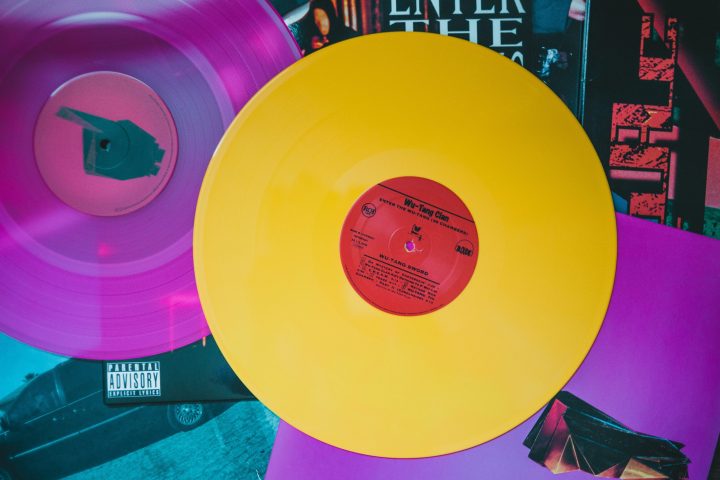
Grooves
LP records are characterized by their distinct grooves. These grooves, on each side of the vinyl, house the audio signal in a tangible form. As the stylus needle of a turntable delicately traces them during playback, it translates these patterns into the musical sounds we hear.
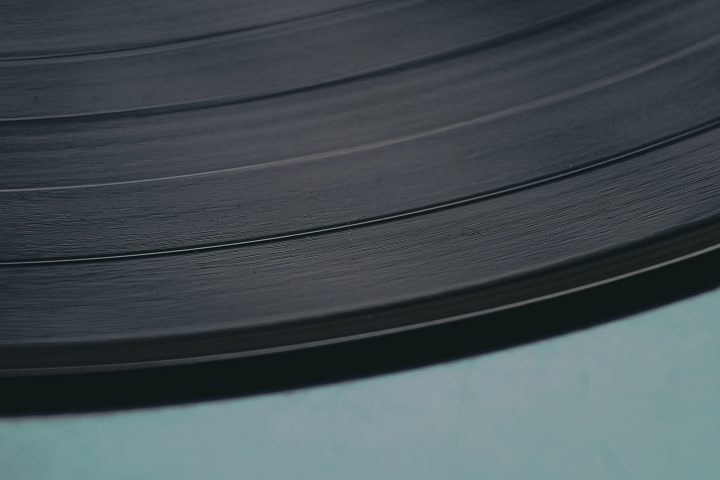
Label
In the center, of an LP is the label, a vital component that not only adds a visual identity but also aids in accurately placing the record on the turntable. The label provides crucial details such as the album title, artist, tracklist, and often the record label’s logo. It’s a small yet significant part that adds to the overall aesthetics and functionality of the LP.
Sides
An LP is not a single-sided entity; it presents a duality of sound. Each LP consists of two sides, Side A and Side B, with music distributed across these sides. So when you’re done enjoying one side, you simply flip it over to continue the musical journey on the other.
Play Hole
At the very core of the LP lies the hole in the middle, a seemingly simple yet vital component. This hole allows for the LP to be placed securely on the turntable’s spindle, ensuring a central and stable rotation during playback. It’s a fundamental part that maintains the balance and symmetry of the LP as it spins.
Jacket
The jacket is the protective cover of the LP, often made of cardboard. It’s the exterior shell that shields the vinyl disc and its grooves from dust, scratches, and damage. Additionally, the jacket frequently features elaborate artwork, liner notes, and additional information about the music and artist, making it an integral part of the overall LP experience.
Sleeve
This thin, anti-static, and occasionally translucent layer offers extra protection for the LP, guarding it against potential static buildup and dust.
How do LP Records Work?
LP (Long Play) records operate on a fundamental principle of analog audio storage and playback.
The process begins with the engraving of music or sound onto vinyl grooves during the manufacturing stage. These grooves represent the sound wave’s characteristics, etched in a continuous spiral pattern on the vinyl’s surface.
During playback, a stylus needle on the turntable’s tonearm is carefully placed in the grooves. As the record spins, the stylus follows the grooves, experiencing the variations in the groove’s depth and shape. These movements translate into mechanical vibrations, then converted into electrical signals by the turntable’s cartridge. The cartridge amplifies and sends these signals to an amplifier, ultimately producing sound through speakers.
LPs store sound by using the physical modulations in the groove, and the resulting sound is characterized by its warm, full, and nostalgic tone, distinguishing it from digital audio formats.
How are LP Records Made?
LPs are made pretty much in the same way all other vinyl records are made. It all begins with the primary material, which is, as you can probably guess by now – vinyl. However, there are necessary steps before the actual vinyl pressing comes into place.
Step 1: Preparing Music for Vinyl
The first step in crafting an LP record involves the preparation of the music for vinyl. This stage is crucial as it involves adjusting and fine-tuning the audio to ensure it translates effectively onto the vinyl format.
Step 2: Master Disc
Following this, a master disc is created, which serves as the primary prototype for the vinyl record. This disc, often made of lacquer, is cut with extreme precision to capture the audio in its purest form.
Step 2: Producing The Stamper
From the master disc, the stamper, a negative of the grooves, is created. The stamper is essential in the mass production of vinyl records. It serves as the source for pressing the records. One stamper is used for each side of the record, so a full LP requires two stampers, one for Side A and another for Side B.
Step 4: Vinyl Pressing
Next comes the actual vinyl pressing. The stampers are clamped together in the pressing machine, and a blob of vinyl (also called the “biscuit”) is placed in the center. The stampers are then pressed together, squeezing the vinyl into the desired shape, including the characteristic grooves.
Following the pressing process, the excess vinyl surrounding the disc is trimmed off. The center hole is then punched out. At this stage, any excess material or “flash” on the edges is carefully removed.
After the trimming and hole punching, the record goes through a cooling process. This cooling phase solidifies the vinyl and brings the record to its final, sturdy form.
Step 5: Quality Control
Once cooled, the records undergo an inspection for quality control. They are checked for any visible imperfections or defects in the grooves, as even minor issues can significantly impact sound quality. Records passing inspection move on to the packaging stage.
Step 6: Packaging
In the packaging phase, the records are sleeved, usually in a paper or plastic-lined sleeve to prevent scratches. Finally, they are inserted into a protective outer jacket, often featuring artwork, track listings, or information about the artist and album. This completes the manufacturing process before the records are shipped for distribution.
Comparison with Other Formats
When we discuss LP, EP, Single, and Double LP, it’s important to understand that these terms are used both as album formats (indicating the length or number of tracks) and as vinyl formats (relating to size, playback speed, and content capacity).
LP vs. EP
LP (Long Play) records and EP (Extended Play) records are both vinyl formats, each with distinct features, designed to cater to various listening experiences. The main difference between them is the length of music and the number of tracks they can hold. EPs are typically smaller in size compared to LP records, often being 7 or 10 inches in diameter, and usually spin at 45 revolutions per minute (rpm). They usually feature around three to five songs on each side, making them a bridge between a single and an album.
LP vs. Double LP
Double LP records, as the name implies, comprise two vinyl records. They typically spin at the standard 33 1/3 rpm, the same as LPs, allowing for the standard duration for each track. They measure 12″ and are ideal for lengthy albums, live recordings, or concept albums.
LP vs. Single
Single records, typically 7 inches in diameter, are designed for individual songs. They usually have one song on each side and often play at 45 revolutions per minute. Singles can, however, also be released on 12″ records. The reason for this is improved audio quality and the fact that not all record players can play 7″.
Why all the different sizes and speeds?
The amount of music a vinyl record can hold depends on two primary criteria: the record’s diameter and its rotational speed. These specifications determine the total playing time available on the vinyl medium. The larger the diameter of the record, combined with the speed at which it rotates, dictates the overall capacity for audio content that can be accommodated on the disc.
Final Tones
And there you have it, folks, a comprehensive journey through the world of LP records. From their historical significance to the intricate details of their manufacturing, we’ve delved deep into what makes LPs more than just a format for music.
So, the next time you lower that stylus onto a vinyl groove, remember you’re not just playing music, but connecting with a piece of musical history.
FAQs
Is an Album and an LP the Same Thing?
Albums and LPs are closely related but not precisely the same. An album generally refers to a collection of music tracks, irrespective of the format it’s presented in—vinyl, CD, digital, and so on. On the other hand, LP, which stands for Long Play, specifically refers to vinyl records that typically play at 33 1/3 revolutions per minute (RPM) and offer a longer playtime.
Are Vinyl and LP the same?
Not quite. Vinyl is a broader term encompassing any audio format that utilizes vinyl material for playback. This includes not only LPs but also EPs (Extended Plays) and singles. LPs, on the other hand, are a specific type of vinyl record characterized by their longer playtime. So, all LPs are vinyl records, but not all vinyl records are LPs!


